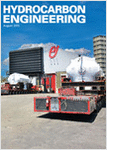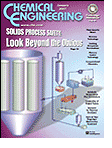Monday, June 7, 2010
Download
Thanks to Ankur
Related Topic
Labels: Hydraulic, Piping, Pressure Drop
Sunday, June 6, 2010
Firewater, service, portable and drinking water network is common network present in most Oil & gas, Refinery and Industry plant. Water balancing in this network is important and critical in maintaining a constant supply to all users. Correct frictional loss estimation within network is the key activity in providing a well balance of water supply. Hazen-William formula is one the method widely accepted and used in industry in estimating frictional loss.
Hazen-William frictional loss is a function of fluid velocity, hydraulic radius and a constant subject to fluid condition and type of pipe. Equation as follow :
C Change with Pipe Material
Hazen-William friction loss coefficient (C) subject to condition and type of pipe. It possibly range from 60 to 150. The following summary listed the Hazen-William friction loss coefficient (C) for different type of material
(source : Handbook of Chemical Engineering Calculation)
Another set of Hazen-William friction loss coefficient also listed in NFPA 15-2007.
(source : NFPA 15-2007)
From above figures, the C factor is almost decrease with surface roughness.
C Decrease With Service Life
One shall take note that Hazen-William friction loss coefficient will decrease with service life. From King & Crocker "Piping Handbook", C = 120 when the pipe is new and decrease to C=90 after 20 years. From "Handbook of Chemical Engineering Calculation", C factor for a new Cast-iron pipe (30 inches) is 130, decrease to 120 after 5 years, decrease to 115 after 10 years, decrease to 100 after 20 years, decrease to 90 after 30 years, decrease to 80 after 40 years and decrease to 75 after 50 years.
An excel spreadsheet prepared by Ankur is under reviewed. Find out in "Quick Estimation of Frictional Loss in Water Network - Spreadsheet Available".
Labels: Hydraulic, Piping, Pressure Drop
Hydrocarbon Engineering, a leading source of technical and analytical information for the downstream oil and gas processing sector. After many months of suspension, FREE Hydrocarbon Engineering is available for subscription now. Try your luck by clicking here.

12 month subscription package to Hydrocarbon Engineering will include: 12 monthly issues of Hydrocarbon Engineering: Offering a mix of well researched international reports, regional forecasts, technical articles and case studies, and including the annual "World Review", and "Engineering Contractor's Overview" features. Hydrocarbon Engineering is packed with key information covering all aspects of the hydrocarbon processing sector including in-depth technical features - expert analysis and case studies - country reports - regional overviews - business news and comment, all tailored specifically to meet the needs of a global readership
Subscript FREE Hydrocarbon EngineeringRelated Post
- Tips on Succession in FREE Subscription
- Most Important & FREE Magazines That I Read are in Softcopy
- Non - Technical Quick References for a Chemical & Process Engineers
- More You Share More You Learn
- Knowledge is Own by Everyone but Not Someone
Labels: E-Doc, Education, Learning
Process engineering design involve preliminary equipment sizing during initial conceptual phase. It is mainly to identify the magnitude of major equipment potentially install in a plant. This is rather important during conceptual phase as equipment dimensioning will provide sufficient key information for budgetary costing which possibly provide direction in Process Engineering Design.
Recommended :
- Subscribe FREE - Chemical Engineering
- Tips on Succession in FREE Subscription
 Process simulation is commonly conducted for all phases of design e.g. Preliminary Design, Basic Design, Front-End Design, Detailed Design, etc. Process simulation enable production of heat and material balance and provide basic process parameters for equipment specification and sizing. Conventionally equipment sizing is conducted manually and vendor preliminary sizing program / software. Transfer of process parameters to vendor software or spreadsheet will require time and effort and also subject to erroneous risk of data transfer. Therefore Process Simulation provider have taken extra effort to provide additional equipment sizing utilities in the Process Simulator to aid Process Engineer to identify system capacity and rule out technical not feasible process option. ASPEN HYSYS have done the same to assist user.
Process simulation is commonly conducted for all phases of design e.g. Preliminary Design, Basic Design, Front-End Design, Detailed Design, etc. Process simulation enable production of heat and material balance and provide basic process parameters for equipment specification and sizing. Conventionally equipment sizing is conducted manually and vendor preliminary sizing program / software. Transfer of process parameters to vendor software or spreadsheet will require time and effort and also subject to erroneous risk of data transfer. Therefore Process Simulation provider have taken extra effort to provide additional equipment sizing utilities in the Process Simulator to aid Process Engineer to identify system capacity and rule out technical not feasible process option. ASPEN HYSYS have done the same to assist user.
- Subscribe FREE - Chemical Engineering
- Tips on Succession in FREE Subscription
The following document is a HYSYS SIZING guide which provide information in using Sizing Utilities and provide the theories and equations used in the sizing Utilities. It is particularly important for an HYSYS Sizing Utilites user have clear understanding of the utilities background and limitation.
Download
Related Topics
Related Topics
- Simulation of Gas Power Plant Using HYSYS
- HYSYS Simulation of MEA Based CO2 Removal
- Correct model and thermo package in Amine system simulation using HYSYS
- Incompatibility HYSYS Version & Its File...What to do ?
- Adjusted Method For Compressor Settle Out (with Vapor & Liquid) Using HYSYS
- Simple Method For Compressor Settle Out (Vapor Only) Using HYSYS
- HYSYS related
Labels: HYSYS, Process simulation
FREE Hydrocarbon Processing for JUNE 2010 is available now...

Select Articles from the June 2010 Issue
****************************
How will carbon emissions regulations revise energy conservation economics?
Including the cost of carbon in refinery project economics has the potential to convert previously marginal energy project into more attractive options
Low-cost advanced process control project captures energy savings in utilities area
This low-cost project resulted in over $300,000 per year in benefits
Modify your vacuum-tower transfer line to increase benefits
Designing the vacuum unit is a challenge. Revamping the transfer line can make this unit more profitable.
Advanced process control: quick and easy energy savings
Here are some of the energy savings benefits routinely produced by implementing advanced process control
Consider low-voltage AC drives for hazardous areas
Massive Such drives used with electric motors can offer significant process improvements and energy savings for equipment used in explosive zones
Trading silicon for carbon: how to reduce energy usage through automation
The average plant can conservatively achieve 15% energy savings through this technology
****************************
If you yet to be subscriber of Hydrocarbon Processing, requested your FREE subscription via this link (click HERE). Prior to fill-up the form, read "Tips on Succession in FREE Subscription".
Related Post
- Tips on Succession in FREE Subscription
- Most Important & FREE Magazines That I Read are in Softcopy
- Non - Technical Quick References for a Chemical & Process Engineers
- More You Share More You Learn
- Knowledge is Own by Everyone but Not Someone
Labels: E-Doc, Education, Learning
Process Intensification (PI) is an approach to develop an innovate systems and practices offer a drastic reduction in chemical and energy consumptions, improvements in process safety, decreased equipment volume and waste formation and increased conversions and selectivity towards desired product(s). More detail discussion on PI has been presented by P.J. Lakhapate in "Process Intensification".
Another approach was introduced by R.S.H. Mah and co-workers is internal heat integrated distillation columns (iHIDiCs). It is common known that distillation is an energy intensive separation in particular those mixtures with very llow relative volatilities. Typical mixture systems are propylene-propane, ethyl benzene-styrene systems, etc. Several method such as thermal coupling, heat integration, vapor recompression and heat pumps were used to reduce energy consumption and improve distillation efficiency .
In vapor recompression designs, the vapors leaving the top of the distillation column are compressed and then are condensed in the reboiler of the same column, providing the heat needed for vapor generation. Internal heat integrated distillation columns (iHIDiCs) are further intensifications of vapor recompression principle. These columns combine the advantages of both direct vapor recompression and adiabatic operation and can have significantly lower energy demands than common vapor recompression distillation columns or heat pumps.
A systematic design hierarchy was proposed for iHIDiCs, including thermodynamic and hydraulic approaches. Starting from a conventional design, a full iHIDiC design can be achieved by performing basic design assumptions to conventional data. Temperature profiles are a key for heat integration, while hydraulic calculations are necessary to quantify the ability of a column design to place heat panels.
Related Topic
Labels: Process Intensification




